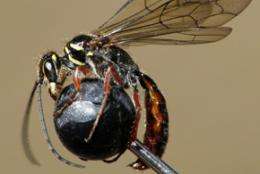Microdots spot on for wasp study

(PhysOrg.com) -- New research by scientists at The Australian National University will see wasps being tracked in the same way as stolen cars – using specialist microdot technology.
The Research School of Biology researchers published a paper in the latest edition of Agricultural and Forest Entomology outlining a successful new tracking technique, which allows them to study insects that were previously too small to track individually.
Lead researcher Michael Whitehead was working with the parasitoid thynnine wasp to investigate its role in orchid pollination, but found available tracking methods impractical.
“Bee tags were previously used to keep track of small animals, but they were too big in this case, and the electronic devices we could find weren’t going to work,” he said. “So my brother and I came up with the idea to test out microdots as a tracking system.”
Microdots were developed by the Australian company DataDot Technology, as a way of tracking stolen property. The plastic microdots are half a millimetre in diameter and contain a personalised code which can be read under a magnifier.
To test the method, the research team captured wasps around Black Mountain in Canberra and attached coded microdots to their backs with liquid paper or nail polish before releasing them. After being recaptured, 84 per cent of tagged wasps retained a legible microdot, proving the method to be effective and durable.
“When you’re able to individually mark the wasps you can get data on population size, movement and longevity,” Mr Whitehead said.
“The method also opens the door to a whole range of applications beyond research, ranging from tracing oysters stolen from oyster farms to tracking elephant tusks and rhinoceros horns to combat poaching.”
Provided by Australian National University


















